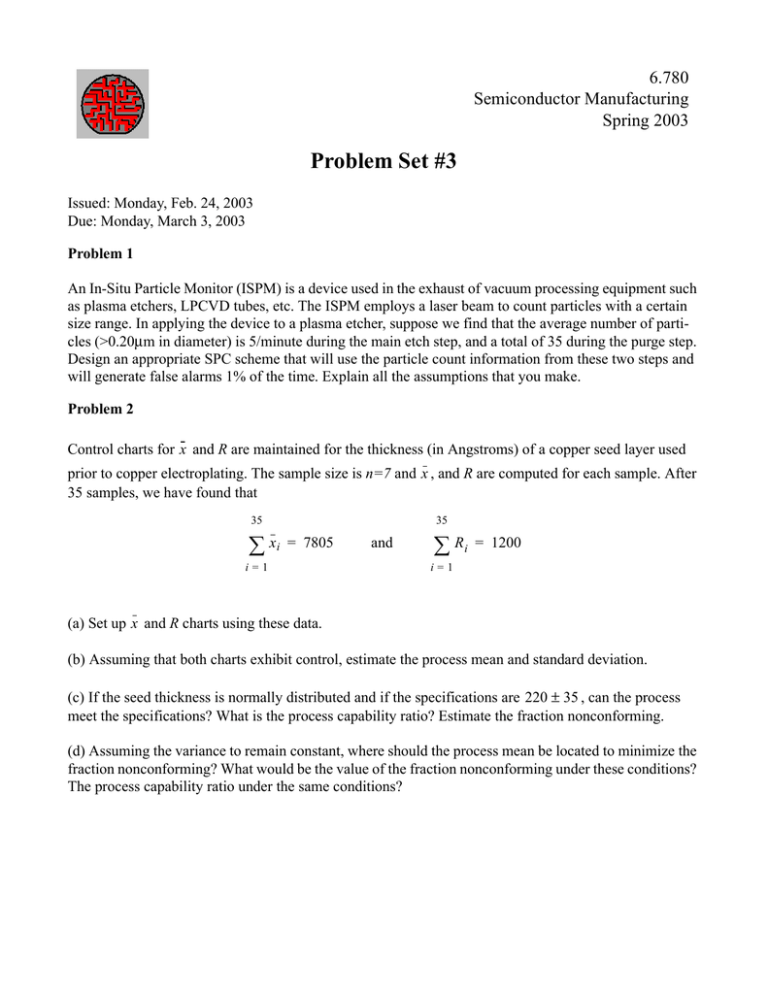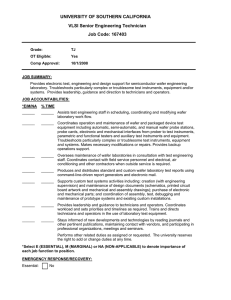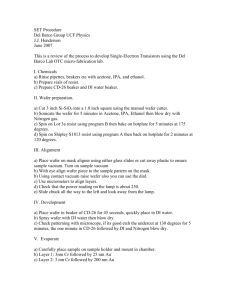Problem Set #3 6.780 Semiconductor Manufacturing Spring 2003
advertisement

6.780 Semiconductor Manufacturing Spring 2003 Problem Set #3 Issued: Monday, Feb. 24, 2003 Due: Monday, March 3, 2003 Problem 1 An In-Situ Particle Monitor (ISPM) is a device used in the exhaust of vacuum processing equipment such as plasma etchers, LPCVD tubes, etc. The ISPM employs a laser beam to count particles with a certain size range. In applying the device to a plasma etcher, suppose we find that the average number of particles (>0.20µm in diameter) is 5/minute during the main etch step, and a total of 35 during the purge step. Design an appropriate SPC scheme that will use the particle count information from these two steps and will generate false alarms 1% of the time. Explain all the assumptions that you make. Problem 2 Control charts for x and R are maintained for the thickness (in Angstroms) of a copper seed layer used prior to copper electroplating. The sample size is n=7 and x , and R are computed for each sample. After 35 samples, we have found that 35 35 ∑ xi = 7805 i=1 and ∑ Ri = 1200 i=1 (a) Set up x and R charts using these data. (b) Assuming that both charts exhibit control, estimate the process mean and standard deviation. (c) If the seed thickness is normally distributed and if the specifications are 220 ± 35 , can the process meet the specifications? What is the process capability ratio? Estimate the fraction nonconforming. (d) Assuming the variance to remain constant, where should the process mean be located to minimize the fraction nonconforming? What would be the value of the fraction nonconforming under these conditions? The process capability ratio under the same conditions? Problem 3 The following x and S charts based on n=4 have shown statistical control: S chart x chart UCL = 710 CL = 700 LCL = 690 UCL = 18.08 CL = 7.979 LCL = 0.000 (a) Estimate the process parameters µ and σ. (b) If the specifications are at 705 ± 15 , and the process output is normally distributed, estimate the fraction nonconforming. (c) For the x chart, find the probability of a type I error, assuming σ is constant. (d) Suppose the process mean shifts to 693 and the process standard deviation simultaneously shifts to 12. Find the probability of detecting this change on the x chart on the first subsequent sample. What is the average run length (ARL) for detecting this shift? (e) For the shift of part (d), find the probability of type II error. Problem 4 Photoresist thickness is spun on wafers during photolithographic sequences. After the spin, any wafer with resist thickness less than 1.6µm is cut out of the wafer track for possible rework. The resist thicknesses of 25 successive wafer are shown below. Set up a moving range control chart and a control chart for individuals. Estimate the mean and standard deviation of the resist thickness. If the process remains in control at this level, what percentage of wafers will be reworked? Resist Thickness Wafer # 1 2 3 4 5 6 7 8 9 1.611 1.608 1.612 1.610 1.610 1.611 1.612 1.609 1.612 Resist Thickness Wafer # 10 11 12 13 14 15 16 17 18 1.610 1.609 1.607 1.613 1.612 1.610 1.608 1.613 1.615 Resist Thickness Wafer # 19 20 21 22 23 24 25 1.612 1.610 1.608 1.607 1.611 1.613 1.610 Problem 5 In the semiconductor industry, the production of integrated circuits involves many steps, some of which occur on batch processing equipment, and some of which take place on single wafer processing equipment. In each case, a production lot consisting of typically 25 wafers travels the process sequence together. It is usually necessary to estimate several components of variation: within-wafer, between wafer, between lot, and the total variation. For this problem, you can assume that the lot to lot variation is random and normal, the wafer to wafer variation is random and normal, but the site to site (or within wafer) variation has both a fixed systematic spatial component as well as random and normal variation. (a) Suppose that one wafer is randomly selected from each lot and that a single measurement on a critical dimension of interest is taken (assume that the same location is measured on each seclected wafer). Which components of variation could be estimated with these data? What type of control charts would you recommend? (b) Suppose that the randomly selected wafer from the lot is instead tested at five locations (say, the center and four points at the circumference). The average and range of these within-wafer measurements are xWW and RWW, respectively. What components of variability are estimated using control charts based on these data? (c) Suppose that one measurement point on each wafer is used (again, assume this is at some fixed location on the wafer) and that this measurement is recorded for three randomly selected wafers from each lot. The average and range of these between-wafer measurements are xBW and RBW, respectively. What components of variability are estimated using control charts based on these data? Would it be necessary to run separate x and R charts for all five locations on the wafer? (d) Consider the question in part (c). How would your answer change if the test sites on each wafer were randomly selected and varied from wafer to wafer? (e) What type of control charts and rational subgroup scheme would you recommend to control the lot-tolot variability? Acknowledgements: Problems 3 and 4 are based on Exercises 5-44 and 5-45 in D. Montgomery, “Introduction to Statistical Quality Control,” Third Edition, Wiley, 1996.






